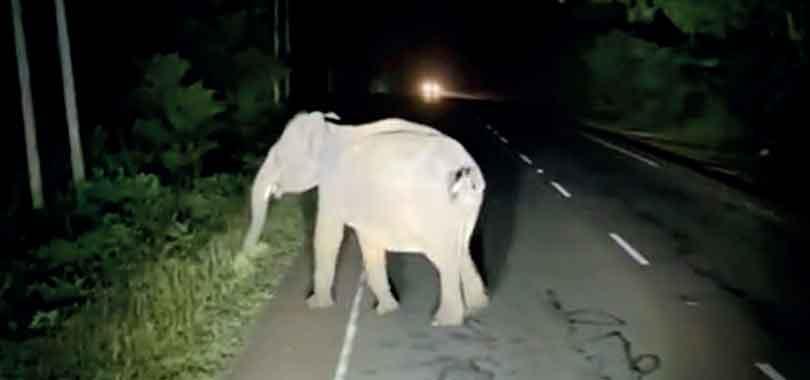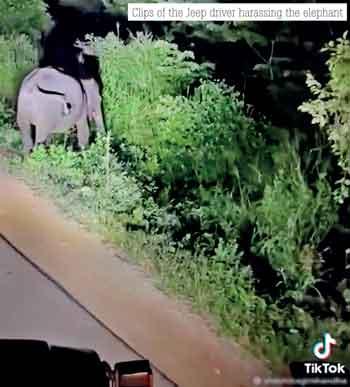08 Feb 2022 - {{hitsCtrl.values.hits}}

Clips of the Jeep driver harassing the elephant
 Chasing an elephant with heavy flashlights, recording it on video with party music on is not the best way to go on a safari. But, in a video that is currently being widely shared on social media (TikTok), a jeep driver encounters a young elephant on a road, at night, and then proceeds to drive the vehicle at him, eventually pushing him to the edge of the road. While investigations are underway, animal rights groups have called authorities to take stern action and also request media giants to impose controls on sharing contents related to animal cruelty on social media. A number of such videos have been circulating recently.
Chasing an elephant with heavy flashlights, recording it on video with party music on is not the best way to go on a safari. But, in a video that is currently being widely shared on social media (TikTok), a jeep driver encounters a young elephant on a road, at night, and then proceeds to drive the vehicle at him, eventually pushing him to the edge of the road. While investigations are underway, animal rights groups have called authorities to take stern action and also request media giants to impose controls on sharing contents related to animal cruelty on social media. A number of such videos have been circulating recently.
Enough evidence available to prosecute the suspect
“This is completely unacceptable, inhumane behaviour,” opined former Department of Wildlife Conservation Director General Dr. Sumith Pilapitiya. “This man is taking pleasure in harassing an innocent animal who is on the side of the road, causing absolutely no harm to anybody. What this man is doing causes stress and fear in the elephant and could cause long term adverse consequences, not only to the elephants but to people as well. Elephants are generally risk averse and do their best not to come into conflict with humans--just the way this elephant was behaving. This type of continued harassment will eventually lead the elephant to react by charging or attacking the vehicle. We know from experience that when an elephant becomes aggressive, it is people who panic and run or drive away. That makes the elephant realise that all it needs to do is to become aggressive and it may not be harassed. The more aggressive it becomes the less it will be harassed. This is what leads to elephants becoming aggressive towards humans and vehicles. In such situations, the elephant is trying to defend itself from the harassment it has suffered at the hands of vehicles and people pursuing and chasing them in the past. The elephant is unable to distinguish which vehicles or people harass them, it just associates its past harassment with humans and vehicles, so it starts attacking any vehicle or person. That is how so-called “problem elephants” are created. It is our stupidity that creates “problem elephants” and we then blame elephants for being a problem.
 “I think there is adequate evidence in the video clip that is circulating on social media to prosecute this person,” Dr. Pilapitiya added. “The license plate of the vehicle is visible and his name and phone number where he advertises “night safaris” is also available and there he can be located and prosecuted.”
“I think there is adequate evidence in the video clip that is circulating on social media to prosecute this person,” Dr. Pilapitiya added. “The license plate of the vehicle is visible and his name and phone number where he advertises “night safaris” is also available and there he can be located and prosecuted.”
Speaking about the legal provisions, he referred to Part II of the Fauna and Flora Protection Ordinance (FFPO), Section 20.(1).a) under the section on “elephant offences” states the following: “Any person, in contravention of this Part of this Ordinance or contrary to the tenor of any license issued to him there under hunts, shoots, kills, injures, takes, follows, or pursues any elephant.........shall be guilty of an offence and shall on conviction be liable to a fine not less than one hundred and fifty thousand rupees and not exceeding five hundred thousand rupees or to a imprisonment of either description for a term not less than two years and not exceeding five years or to both such fine and imprisonment, and where any person who is convicted of an offence mentioned in paragraph a) of this section....”

“ The license plate of the vehicle is visible and his name and phone number where he advertises “night safaris” is also available and there he can be located and prosecuted.
Dr. Sumith Pilapitiya
“While harassment is not mentioned in the FFPO (which is a major gap in the FFPO because in my view, the prevention of harassment of wildlife should be included in the FFPO), what this man is doing is following and chasing the elephant, which falls within the definition of pursue. Therefore, there is provision within the FFPO to prosecute this person and the Department of Wildlife Conservation should prosecute this man and make an example of him so that it will deter other people from harassing wildlife in general and elephants in particular.”
“ This is not an isolated incident. Not just elephants, but other wildlife, too, are harassed in this way and videos of it shared widely.
Of recent years, there have been international calls for social media providers to monitor and delete posts which celebrate racial, sexual, homophobic and other types of abuse. Why is the sharing of content with animal abuse exempt from these controls?
Impose controls on sharing incidents of animal cruelty on social media : WNPS
The Wildlife & Nature Protection Society (WNPS) has, in a written communication, requested the Department of Wildlife Conservation (DWC) to take prompt and determined action against an individual who harassed a young wild elephant, on a public road, at night. Issuing a statement, the WNPS said that this act is made even more deplorable by the fact that over thousand people had ‘liked’ it; this in a country that alleges its guidance by a philosophy of tolerance for all beings,” a statement by WNPS read.

Investigations underway
When contacted, Department of Wildlife conservation Director General M. G. C Sooriyabandara said that the video clips have been sent to department officials and that investigations are now underway.
“The matter was reported to TikTok but the individual, has since, closed his account and opened a fresh, ‘ private’, one; no doubt to continue practising his sadistic pleasures for the benefit of his like-minded following. Prior to this, however, his details were collected and passed to the DWC who, we trust, will take appropriate action against him, using the evidence that he has so proudly shared with the world.”
“This is not an isolated incident. Not just elephants, but other wildlife, too, are harassed in this way and videos of it shared widely. Of recent years, there have been international calls for social media providers to monitor and delete posts which celebrate racial, sexual, homophobic and other types of abuse. Why is the sharing of content with animal abuse exempt from these controls? The WNPS earnestly requests all these media giants to re-examine their content and ensure that animal cruelty is not shared, and celebrated. It will do much for the cause of animal rights, and wildlife conservation,” the statement read.
23 Nov 2024 7 hours ago
23 Nov 2024 7 hours ago
23 Nov 2024 9 hours ago
23 Nov 2024 23 Nov 2024
23 Nov 2024 23 Nov 2024